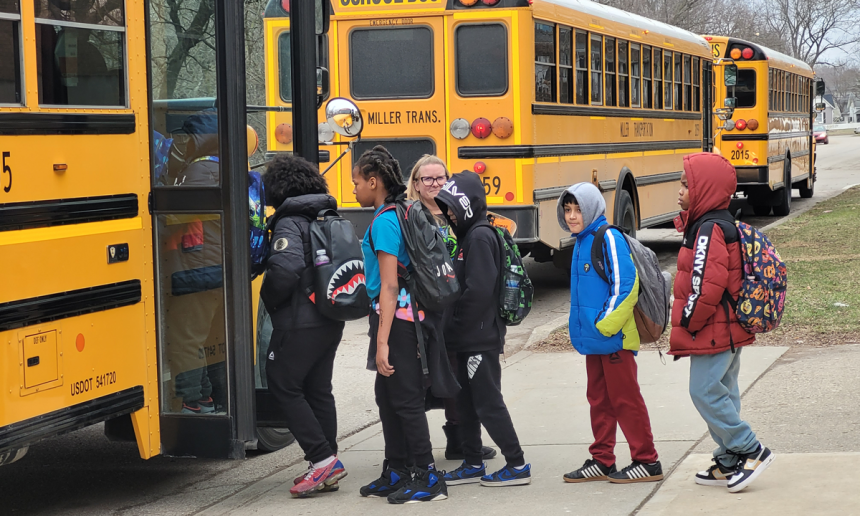A push from Indiana’s legislature for the Indianapolis school district and charter schools to share buses and school buildings is raising tempers, as opponents jockey over scarce resources and control over how to divide them.
Meanwhile, a friendlier bid for schools to voluntarily cooperate has enlisted a few participants — a microschool chain, Indianapolis charter schools and schools in and near South Bend.
The first proposals from the panel tackling the issue, the Indianapolis Local Education Alliance, will be presented later this month, with recommendations to the city and state legislature due in December.
Get stories like this delivered straight to your inbox. Sign up for The 74 Newsletter
But families, education advocacy groups and the Indianapolis school board are already at odds over hot-button issues such as which students should be offered school buses, or whether district or charter schools get to use old and empty school buildings.
There’s also conflict over whether any more charters should open in Indianapolis, or whether the school board, the Indianapolis mayor or some new panel should referee competing claims for assets.
To some, the entire process is an attack on the Indianapolis school district and an attempt to dilute its power in favor of charter schools.
Tiny Indiana District With Online School Worth Millions Ordered To Close
“Few of us want to feed the goals of the far right MAGA legislators who want to divide and ruin Indianapolis schools,” resident Kate Scott told the panel last month. “This gives them an excuse to strip us of our rights to make community decisions, and to then force an all charter and voucher landscape… and floods of public funding for privately run religious schools.”
Others view the effort as overdue, since more than half the students in Indianapolis attend charter schools. Most Indianapolis charter schools do not offer buses to students, saying that paying for them could mean cutting teachers.
“We need to listen to what the families want for transportation,” resident Kim Graham told the panel at its October meeting. “It doesn’t need (the district) or charter running the bus system. We need to elect a whole new board that does know transportation, that will be able to figure out how our children can get to school.”
Meanwhile, a separate push by the legislature to encourage schools to share resources is advancing in a much friendlier way since it’s voluntary and not an order. The Indiana Department of Education gave the OK in October for three partnerships between charter schools and districts — in Indianapolis, South Bend and one a microschool network that hopes to expand statewide — to start sharing services as a three-year pilot starting in the fall of 2026.
In the higher stakes charter vs district debate in Indianapolis, the alliance has two task forces, one looking at transportation issues and the other at school buildings, which have been meeting privately and will share their recommendations with the full panel Nov. 19.
The thornier matter of who would oversee sharing is also in play. The board heard Oct. 22 from representatives from Denver and Washington, D.C., about how those cities put single boards in charge of funding, school quality, transportation and creation of new schools for both charter and district schools.
Looming in the background are several real threats, including legislators that proposed wiping out the school district in favor of charters, a declining population that leaves schools fighting for students to stay afloat, and the district’s budget woes. The Indianapolis Public Schools has closed several schools in recent years. A tax that brings in about $40 million a year will expire in 2026, needing voter approval to continue.
A National ‘Blueprint’?: Indiana Shifts Millions in Taxes To Charters From Districts
One incentive for the sides to strike a deal is that voters with children in charter schools could be more willing to pass a tax for the district if their children also benefit.
Varying groups have pressed dueling requests to the Alliance, including the IPS school board, which called Oct. 3 for a moratorium on new schools starting in the city, in response to 9,000 seats in charter and district schools sitting open.
“There are currently 103 schools serving approximately 41,000 students,” the board said. “Too many schools competing for a limited pool of students and resources undermines the health of our entire system.”
“We do not need any more schools in the IPS boundary,” the board continued. “The long-term success of Indianapolis students depends on right-sizing the number of schools within the boundary—ensuring we have the right number of schools, in the right places, to serve all students effectively.”
Other requests include:
-
The pro-charter advocacy group Stand For Children delivering a petition with 2,000 signatures to the Alliance in September calling for transportation for all students and for a new school board to oversee charter and district schools.
-
The district’s Parent Council circulated a petition calling for a moratorium on new charter schools, for the elected school board to keep its powers, for repeal of a state law allowing charters to buy closed school buildings for $1 and for other limits on charter school power.
-
The Central Indiana Democratic Socialists of America started its own petition against any control of the district going to the mayor or any new appointed panel.
The second effort to have Indiana schools share resources is moving forward too with three partnerships, though without the same debate.
The Indiana Microschool Collaborative, which started this fall and hopes to offer an efficient way for microschools to launch across the state, will be one of the three. The model, created by the Eastern Hancock school district, calls for the microschools — independent schools with only a few students — to save money by using the Eastern Hancock central office for its human resource and other administrative needs.
The second has the Mishawaka school district near South Bend collaborating with the Career Academy Network of five charter schools in South Bend and the Boys & Girls Clubs of the Northern Indiana Corridor.
The charter schools and district already have students attending the same afterschool and summer programs, said Jeremy Lugbill, CEO of the charter network. And the Boys and Girls Clubs help run one of the network’s schools located at a Boys and Girls Club facility.
The schools will likely all participate in a joint school for students with academic troubles, among other ways of collaborating.
“I’m optimistic,” Lugbill said. “Have we done it before? No, but I believe that people are starting to see the value in collaboration. The bottom line is that a rising tide lifts all boats. We can make each other better.”
The third partnership already has 54 charter schools in the Indianapolis area joining together under Andrew Seibert, the former executive director of the KIPP Indy charter schools who left in September to join the TogetherEd nonprofit for this effort.
Seibert said cooperation between schools already happens, with some charter schools already sharing the same building or sharing with district schools.
Schools, Seibert said, could share buses if they are close by, possibly just for afterschool programs or for homeless students or students with disabilities. Schools that have a good gymnasium or auditorium could let other schools use them for events.
“There are certainly discrete examples of success that we can point to and to learn from,” he said. “But in a lot of ways, this is going to be new ground that we’re breaking.”
The partnership is also sparking speculation, however, that TogetherEd is positioning itself as the body that could take control in the larger Indianapolis effort to share buses and buildings between charters and the Indianapolis Public Schools.
Seibert said it is too early to know what the Alliance will recommend and what TogetherEd’s role will be, but that it is important to start a culture of cooperation between schools now.
“Whatever the future state that we’re building towards is like, we have to start building muscle and getting experience now on it,” Seibert said. “What I’m hopeful…is that by establishing the environment where collaboration is happening and it’s happening consistently with concrete outcomes… we can learn important things and contribute to whatever the shape of the future landscape needs to look like.”









